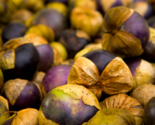Purple tomatillos are uniquely beautiful and rare to find. They’re small and round like a golf ball,
with an average diameter of one or two inches at maturity. Like all tomatillos, the Purple tomatillo
is encased in a papery husk, which turns from green to brown and splits open as the fruit matures.
The fruit itself starts out pale green and ripens to a deep violet color, and that rich purple skin
coloring bleeds into its bright green interior flesh. Purple tomatillos have a tangy-sweet taste, much
sweeter than their green counterparts, with citrus-like hints and sub-acid flavors of plum and pear.
The semi-determinate, heavily branched plants have dark green leaves with striking purple veins, grow
to an average of just three feet, and produce high yields of this exceptional fruit.
Planting Season
Warm
Soil Temp
65 F+
Planting Depth
1/4"
Area to Sow
100' row
Days to Germ.
3-10+
Days to Maturity
65+
Best Planting Method
Transplant
Thin to
?3" apart
Final Spacing
?24" apart
Planting by Zones
Zones 9-10
Tomatillos grow well in the extended warm season of Zones 9 and 10.
Zones 2-8
Sow seeds in starter pots with a heating pad 5-6 weeks before the last frost. Transplant
out after the danger of frost is gone.
Planting Purple Tomatillo Seeds
Tomatillos seeds are easy to start with a few key things. Tomatoes germinate very slowly
in cold soil. If you are starting your seeds early in the season you may want to use a
heating mat to ensure the soil is warm enough for quick germination. Soil temperature
should be 75-90F.
If you are planting seeds in starter pots, plant seeds into thoroughly moist high-quality
seed starting soil. Place seeds on top of the soil and cover with 1/4? of finely sifted soil.
If you plan to direct sow (not recommended), follow the same instructions for starter pots
or plug trays. Once the seedlings have germinated and have a first set of true leaves be
sure to fertilize regularly with an organic liquid fertilizer.
Seedlings can be planted into the garden when they are 7-8 weeks old or 5-6? tall and stocky.
Growing Purple Tomatillos
Tomatillos are easy to grow. You”ll likely get more tomatillos than you know what to do with!
Tomatillo plants can become overloaded with fruit which will bend branches to the ground.
Prune off excess fruits to keep the plant size manageable. Add light support if needed.
A granular organic fertilizer added to the planting area is a good idea if your garden has
poor nutrient content or if you are growing in a new raised bed.
Growing Purple
Tomatillos in Containers
If you are planting tomatoes in containers, make sure your container is at least 20? deep.
Keep in mind containers will dry out faster because they have more surface area and less soil
to hold onto moisture. Mulch heavily on the top layer of soil in the pot to keep the soil
from drying out or heating up too much.
Harvesting Tomatillos
Tomatillos are best harvested at peak ripeness. This is typically when fruits have burst out of their skins.
Southern California Pro-tips
Mulch heavily around your tomatillo to ensure the soil does not dry out or heat up too much.
During our hottest months of August, September, and October, plants can suffer from the heat.
Using shade cloth can help protect the plants from extreme heat.
In July and August keep an eye out for the tomato hornworm which feeds on plants in the
Solanaceae family.
The anthocyanins in Purple tomatillos, responsible for the purple coloring, has cancer-fighting compounds,
and is good source of antioxidants. Tomatillos are known for having decent amounts of beta-carotene,
which is good for your vision, and they are also a good source of niacin, which helps to improve energy
levels throughout the day. Tomatillos also have a positive potassium-sodium ratio, which reduces blood pressure.
Tomatillos are a staple in Mexican cuisine and cooking 101 with tomatillos equals salsa. The tomatillo's
role in the kitchen does not end with salsa, though. Purple tomatillos can be substituted for recipes
calling for green tomatillos, though they are considered more exceptional for their coloring and their
sweeter flavor. Purple tomatillos lend themselves to many different cooking methods. They can be stewed,
fire roasted, grilled, broiled, blanched, puréed, chopped fresh and utilized as an ingredient in applications
both hot and cold. Traditional and authentic accompanying ingredients include corn, tomatoes, garlic, chiles,
avocado, red, white and black beans, tortillas, fresh and aged cheeses. Tomatillos can heighten the flavor of
pork, chicken and seafood in Latin recipes as well as seasonal and regional recipes throughout the months of
late Summer and Fall. Herbal companions include cilantro, basil, mint, epazote, cumin and oregano. As Purple
tomatoes deliver more sweetness, they can also be utilized to make marmalades, jams and preserves. Once
tomatillos are removed front their husk, they should be washed to remove the slightly sticky film from
the skin's surface. Fresh tomatillos in their husks will stay fresh refrigerated in a paper bag for up
to two weeks. Cooked tomatillos can also be preserved by canning them or freezing them for later use.
Purple tomatillos, like green varieties, are a very popular fruit in Latin America, and are a staple of
Mexican and Guatemalan cuisine, particularly for salsas. Tomatillo cultivation became vital to Mexican
agricultural industries in the 1980's, as they began sending about 80% of their annual crop to the United States.
Tomatillos originated in Mexico, and were cultivated by the Aztecs dating back as early as 800 B.C. Purple
tomatillos are still found growing as a wild weed-like plant, invading fields of corn throughout the central
highlands of Mexico. Plants will thrive in temperate to sub-tropical regions with little rainfall and full sun.
This variety will grow well in most regions of the United States, and it is known for being somewhat tolerant
of extreme conditions, from dry farming to slightly cool nights.
